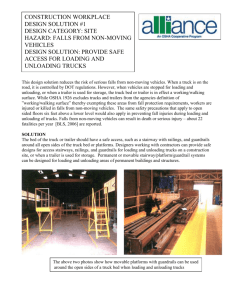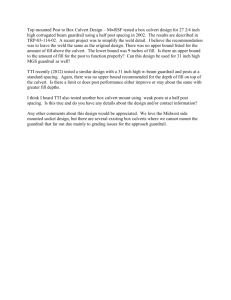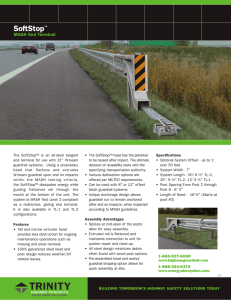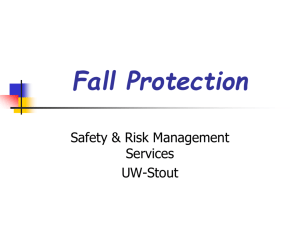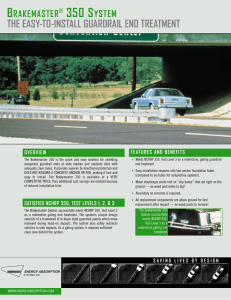Installation Manual - Atlantic Fall Protection
advertisement
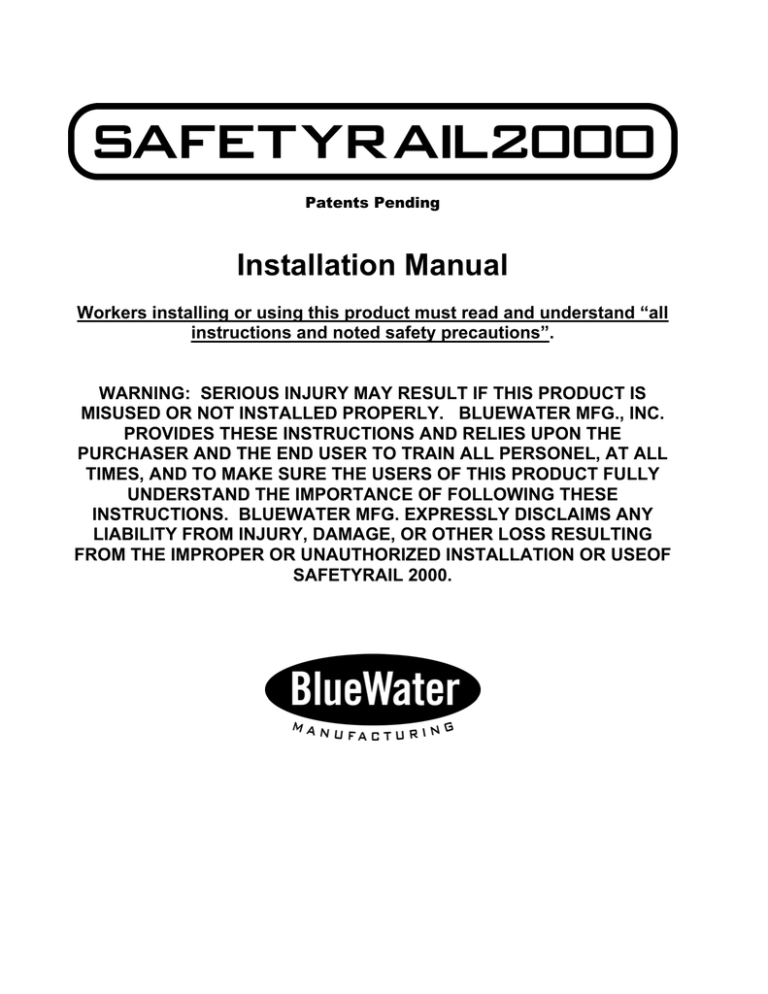
Patents Pending Installation Manual Workers installing or using this product must read and understand “all instructions and noted safety precautions”. WARNING: SERIOUS INJURY MAY RESULT IF THIS PRODUCT IS MISUSED OR NOT INSTALLED PROPERLY. BLUEWATER MFG., INC. PROVIDES THESE INSTRUCTIONS AND RELIES UPON THE PURCHASER AND THE END USER TO TRAIN ALL PERSONEL, AT ALL TIMES, AND TO MAKE SURE THE USERS OF THIS PRODUCT FULLY UNDERSTAND THE IMPORTANCE OF FOLLOWING THESE INSTRUCTIONS. BLUEWATER MFG. EXPRESSLY DISCLAIMS ANY LIABILITY FROM INJURY, DAMAGE, OR OTHER LOSS RESULTING FROM THE IMPROPER OR UNAUTHORIZED INSTALLATION OR USEOF SAFETYRAIL 2000. Patents Pending Installation Manual Workers installing or using this product must read and understand “all instructions and noted safety precautions”. WARNING: SERIOUS INJURY MAY RESULT IF THIS PRODUCT IS MISUSED OR NOT INSTALLED PROPERLY. BLUEWATER MFG., INC. PROVIDES THESE INSTRUCTIONS AND RELIES UPON THE PURCHASER AND THE END USER TO TRAIN ALL PERSONEL, AT ALL TIMES, AND TO MAKE SURE THE USERS OF THIS PRODUCT FULLY UNDERSTAND THE IMPORTANCE OF FOLLOWING THESE INSTRUCTIONS. BLUEWATER MFG. EXPRESSLY DISCLAIMS ANY LIABILITY FROM INJURY, DAMAGE, OR OTHER LOSS RESULTING FROM THE IMPROPER OR UNAUTHORIZED INSTALLATION OR USEOF SAFETYRAIL 2000. 0 Installation Manual - Table of Contents Description: Page No. Safety Precautions 2 SafetyRail 2000 Assembly Instructions 3 Gate Assembly Instructions 4 Outriggers/ Returns 5 ParaRail Installation 6 Duty to Have Fall Protection 7 OSHA Regulations (Standards - 29 CFR) 1926.501 10 Fall protection systems criteria and practices OSHA Regulations (Standards - 29 CFR) 1926.502 1 SAFETY PRECAUTIONS: ! Personnel using this product must be trained on how to install it safely and correctly. ! Check load limit of the surface to make sure that the surface can handle the weight of the SafetyRail 2000 and the personnel installing it. ! SafetyRail 2000 is designed to be used on clean (free of debris) and flat surfaces only. ! Never use SafetyRail 2000 on slippery surfaces. ! Never set up SafetyRail 2000 near electrical wires. Keep the railings at least ten (10) feet from power lines. ! Never use damaged railings or gates. Replace with new product. ! Always use an outrigger at the beginning and end of a continuous run or any interruption of a run. The outrigger should be positioned approximately at a 90 degree angle to the run. See Page 5 of this manual. ! Never use the railings for hoisting. ! Inspect all parts to make sure none are damaged. Replace any parts with new product if damaged. ! Make sure that the bottom of the base has all four rubber pads. Install new pads where missing. ! Where there is no curb or parapet on a leading edge, the bases must be placed back a minimum of 18” from the leading edge. If a curb or parapet is present, you may place the base right next to the vertical rise of said structure. ! On an annual basis, a visual inspection should be made. Make sure all the rail uprights are pinned to the bases and look for damaged rails. Rails should be replaced if damage is present. Contact BlueWater Mfg with any questions or concerns. 2 SafetyRail 2000 (Patents Pending) Installation Instructions These instructions must be followed in order to comply with the Occupational Safety and Health Administration’s regulations: (Standards- 29 CFR) 1910.23 (e) and (Standards - 29 CFR) 1926.502 (b). 1) Space the Bases (2) to the appropriate width and insert the railings (1) into the desired receiving post on the Base. 2) ALWAYS lock the rail to base with the provided Securing Pins (3). Insert Securing Pin through the base post and the visible holes in the railing. Lock Securing Pin in place by opening the lynch pin, inserting the pin in the hole of the Securing Pin and closing the lynch pin. If you do not have enough securing pins, DO NOT set up the sections that can not be secured. Call BlueWater Mfg. immediately for extra securing pins. Make sure to lock both Railing Posts!! When working on some elevated work surface as defined by OSHA’s (Standard - 29 CFR) 1926.501503 and 1910.23 (see back pages of this manual), YOU MUST attach the optional toe-board receivers (Part # 300025) from BlueWater Mfg. A minimum of a 2 X 4 piece of lumber must be used as the toe board. 1) Slide the receiver (5) onto the railings (all the way up to the Cross Bar) and use the lock knob (6) to secure the receiver onto the rail so you can continue the installation. 2) Space the bases (2) to the appropriate width and insert the railings (1) into the receiving post on the base. 3) ALWAYS lock the rail to base with the Securing Pin provided (3). Insert Securing Pin through the base post and the visible holes in the railings. Lock Securing Pin in place by opening the lynch pin, inserting the pin in the hole of the Securing Pin and closing the lynch pin. If you do not have enough securing pins, DO NOT set up the sections that can not be secured. Call BlueWater Mfg. immediately for extra securing pins. Make sure to lock both Railing Posts!! 4) Loosen the lock knobs and position the receivers onto the toe board (4) – Not Provided by BlueWater Mfg., Inc. Retighten the lock knobs against the rail. If you do not have enough lock knobs, call BlueWater Mfg. immediately. 5) Make sure that the board is secured to the toe-board receiver by placing a securing pin (3) or a nail through the hole in the board bracket. 3 ASSEMBLY INSTRUCTIONS FOR SAFETYRAIL 2000 GATE SYSTEMS 1) Slide one Male Hinge (10) down the Hinge Post Assembly (6) making sure that the male end is facing up (see diagram). Securely tighten the Male Hinge at the measurement shown in the diagram. Now slide the other Male Hinge (10) down the post and make sure that the male end is facing down (see diagram). Securely tighten the Male Hinge at the measurement shown in the diagram. 2) Slide the Female Hinges (11) onto the Gate Weldment (5) as shown in the diagram (you will have to remove the bolt from the hinge that it to be located between the top rail and the mid-rail). Using a flat surface, lay the Hinge Post Assembly (6) (w/ Male Hinges attached) and the Gate Weldment (5) next to one another. Using a straight edge, make sure that the top rail is in line with the top of the Hinge Post Assembly. Slide the Female Hinges into the Male Hinges. Align the hinges so that the connection is parallel to the flat surface. Securely tighten the Female hinges in place. Note: The Female Hinges may have to be opened up so that they slide on the tubing more easily. 3) Install Guide Wheel (1) on to Axle. Slide 5/8” SAE Washer (2) on to Axle and secure into place by inserting 3/16” Cotter Pin (3), 4) Lift up the Gate and insert the Hinge Post Assembly (6) into a base (7). Align the Gate Weldment so that it is in line with where the Latch Post (13) will be located. Screw the Locking Handle (8) into the Locking Coupler (9) and make sure it is securely fastened against the base. This will ensure that the Hinge Post does not rotate when in operation. 5) Install Latches (4) on to Gate Weldment. Each Latch will use 2ea 3/8” x 3” Bolts, Nylock Nuts and 4ea Washers. Next, install the Lifting Bar to the latches. Each Latch will use 2ea 3/8” x 3-1/2” Bolts, Nylock Nuts and 4ea Washers. 6) ALWAYS lock the rail to base with the Securing Pin provided (12). Insert Securing Pin through the base post and the visible holes in the railings. Lock Securing Pin in place by opening the lynch pin, inserting the pin in the hole of the Securing Pin and closing the lynch pin. If you do not have enough securing pins, DO NOT set up the sections that can not be secured. Call BlueWater Mfg. immediately for extra securing pins. Make sure to lock both Railing Posts!! 7) Insert the Latch Post (13) into another Base (7) and repeat step # 6 to secure the post into the base. Slide the base and post into a position that enables the Gate Latches to fit around the Latch Post (13). ¾ The Latch Post should not extend beyond the edge of the Latch! Next, look down on the hinge post. You may have to re-align the hinges if they were not installed parallel to each other. Simply align the bottom hinge into position and loosen the top female hinge. Move into position and re-tighten. Remember that the load is on the bottom hinge. If you loosen that hinge, the gate will slide off the top hinge. 4 Outriggers/ Returns YOU MUST ALWAYS USE AN OUTRIGGER ASSEMBLY AT THE BEGINNING AND END OF A CONTINUOUS RUN OR AT ANY INTERUPTION IN A CONTINUOUS RUN! An Outrigger Assembly Consists of: one extra base, one rail section and two securing pins. Assemble this Outrigger to any base that is at the beginning and end of any type of run. The Outrigger must be positioned to approximately 90 degrees to the last base. 5 The ParaRail Important: You must follow these Set-Up Procedures. 1) 2) 3) 4) 5) 6) Measure the cantilevered distance of the ParaRail. Measure the distance from the centers of the ParaRail Legs Measure the distance from the centers of the Outrigger Legs. Using the above measurements: a) Place the bases that are on the leading edge first. Use Measurement No. 1 to get your set back from the leading edge. b) Use measurement No. 2 for the distance between the two bases. c) Use measurement No. 3 for the distances where the Outriggers will be placed. Always install the Outriggers first. Place the Outriggers in the bases and using the provided Securing Pins, pin the rails to the bases. Install the ParaRail into the bases. Using the provided Securing Pins, pin the rails to the base. 6 OSHA Regulations (Standards - 29 CFR) Duty to have fall protection. - 1926.501 OSHA Regulations (Standards - 29 CFR) - Table of Contents "OSHA Regulations (Standards - 29 CFR) - Table of Contents ·1 Standard Number: 1926.501 ·1 Standard Title: Duty to have fall protection. ·1 SubPart Number: M ·1 SubPart Title: Fall Protection Note: Words in this style Font represent areas where SafetyRail 2000 should be used. 1(a) "General." 1(a)(1) This section sets forth requirements for employers to provide fall protection systems. All fall protection required by this section shall conform to the criteria set forth in 1926.502 of this subpart. 1(a)(2) The employer shall determine if the walking/working surfaces on which its employees are to work have the strength and structural integrity to support employees safely. Employees shall be allowed to work on those surfaces only when the surfaces have the requisite strength and structural integrity. 1(b) 1 [b)(1) "Unprotected sides and edges." Each employee on a walking/working surface (horizontal and vertical surface) with an unprotected side or edge which is 6 feet (1.8 m) or more above a lower level shall be protected from falling by the use of guardrail systems, safety net systems, or personal fall arrest systems. 11 ..1926.501(b)(2) 1(b)(2) "Leading edges." 1(b)(2)(i) Each employee who is constructing a leading edge 6 feet (1.8 m) or more above lower levels shall be protected from falling by guardrail systems, safety net systems, or personal fall arrest systems. Exception: When the employer can demonstrate that it is infeasible or creates a greater hazard to use these systems, the employer shall develop and implement a fall protection plan which meets the requirements of paragraph (k) of 1926.502. Note: There is a presumption that it is feasible and will not create a greater hazard to implement at least one of the above-listed fall protection systems. Accordingly, the employer has the burden of establishing that it is appropriate to implement a fall protection plan which complies with 1926.502(k) for a particular workplace situation, in lieu of implementing any of those systems. 1(b)(2)(ii) Each employee on a walking/working surface 6 feet (1.8 m) or more above a lower level where leading edges are under construction, but who is not engaged in the leading edge work, shall be protected from falling by a guardrail system, safety net system, or personal fall arrest system. If a guardrail system is chosen to provide the fall protection, and a controlled access zone has already been established for leading edge work, the control line may be used in lieu of a guardrail along the edge that parallels the leading edge. 1(b)(3) "Hoist areas." Each employee in a hoist area shall be protected from falling 6 feet (1.8 m) or more to lower levels by guardrail systems or personal fall arrest systems. If guardrail systems, [or chain, gate, or guardrail] or portions thereof, are removed to facilitate the hoisting operation (e.g., during landing of materials), and an employee must lean through the access opening or out over the edge of the access opening (to receive or guide equipment and materials, for example), that employee shall be protected from fall hazards by a personal fall arrest system. 11 ..1926.501(b)(4) 1(b)(4) "Holes." 7 1(b)(4)(i) Each employee on walking/working surfaces shall be protected from falling through holes (including skylights) more than 6 feet (1.8 m) above lower levels, by personal fall arrest systems, covers, or guardrail systems erected around such holes. 1(b)(4)(ii) Each employee on a walking/working surface shall be protected from tripping in or stepping into or through holes (including skylights) by covers. 1(b)(4)(iii) Each employee on a walking/working surface shall be protected from objects falling through holes (including skylights) by covers. 1(b)(5) "Formwork and reinforcing steel." Each employee on the face of formwork or reinforcing steel shall be protected from falling 6 feet (1.8 m) or more to lower levels by personal fall arrest systems, safety net systems, or positioning device systems. 1(b)(6) "Ramps, runways, and other walkways." Each employee on ramps, runways, and other walkways shall be protected from falling 6 feet (1.8 m) or more to lower levels by guardrail systems. 1(b)(7) "Excavations." 1(b)(7)(i) Each employee at the edge of an excavation 6 feet (1.8 m) or more in depth shall be protected from falling by guardrail systems, fences, or barricades when the excavations are not readily seen because of plant growth or other visual barrier; 11 ..1926.501(b)(7)(ii) 1(b)(7)(ii) Each employee at the edge of a well, pit, shaft, and similar excavation 6 feet (1.8 m) or more in depth shall be protected from falling by guardrail systems, fences, barricades, or covers. 1(b)(8) "Dangerous equipment." 1(b)(8)(i) Each employee less than 6 feet (1.8 m) above dangerous equipment shall be protected from falling into or onto the dangerous equipment by guardrail systems or by equipment guards. 1(b)(8)(ii) Each employee 6 feet (1.8 m) or more above dangerous equipment shall be protected from fall hazards by guardrail systems, personal fall arrest systems, or safety net systems. 1(b)(9) "Overhand bricklaying and related work." 1(b)(9)(i) Except as otherwise provided in paragraph (b) of this section, each employee performing overhand bricklaying and related work 6 feet (1.8 m) or more above lower levels, shall be protected from falling by guardrail systems, safety net systems, personal fall arrest systems, or shall work in a controlled access zone. 1(b)(9)(ii) Each employee reaching more than 10 inches (25 cm) below the level of the walking/working surface on which they are working, shall be protected from falling by a guardrail system, safety net system, or personal fall arrest system. Note: Bricklaying operations performed on scaffolds are regulated by subpart L - Scaffolds of this part. 11 ..1926.501(b)(10) 1(b)(10) "Roofing work on Low-slope roofs." Except as otherwise provided in paragraph (b) of this section, each employee engaged in roofing activities on low-slope roofs, with unprotected sides and edges 6 feet (1.8 m) or more above lower levels shall be protected from falling by guardrail systems, safety net systems, personal fall arrest systems, or a combination of warning line system and guardrail system, warning line system and safety net system, or warning line system and personal fall arrest system, or warning line system and safety monitoring system. Or, on roofs 50-feet (15.25 m) or less in width (see Appendix A to subpart M of this part), the use of a safety monitoring system alone [i.e. without the warning line system] is permitted. 8 1(b)(11) "Steep roofs." Each employee on a steep roof with unprotected sides and edges 6 feet (1.8 m) or more above lower levels shall be protected from falling by guardrail systems with toe boards, safety net systems, or personal fall arrest systems. 1(b)(12) "Precast concrete erection." Each employee engaged in the erection of precast concrete members (including, but not limited to the erection of wall panels, columns, beams, and floor and roof "tees") and related operations such as grouting of precast concrete members, who is 6 feet (1.8 m) or more above lower levels shall be protected from falling by guardrail systems, safety net systems, or personal fall arrest systems, unless another provision in paragraph (b) of this section provides for an alternative fall protection measure. Exception: When the employer can demonstrate that it is infeasible or creates a greater hazard to use these systems, the employer shall develop and implement a fall protection plan which meets the requirements of paragraph (k) of 1926.502. Note: There is a presumption that it is feasible and will not create a greater hazard to implement at least one of the above-listed fall protection systems. Accordingly, the employer has the burden of establishing that it is appropriate to implement a fall protection plan which complies with 1926.502(k) for a particular workplace situation, in lieu of implementing any of those systems. 11 ..1926.501(b)(13) 1(b)(13) "Residential construction." Each employee engaged in residential construction activities 6 feet (1.8 m) or more above lower levels shall be protected by guardrail systems, safety net system, or personal fall arrest system unless another provision in paragraph (b) of this section provides for an alternative fall protection measure. Exception: When the employer can demonstrate that it is infeasible or creates a greater hazard to use these systems, the employer shall develop and implement a fall protection plan which meets the requirements of paragraph (k) of 1926.502. Note: There is a presumption that it is feasible and will not create a greater hazard to implement at least one of the above-listed fall protection systems. Accordingly, the employer has the burden of establishing that it is appropriate to implement a fall protection plan which complies with 1926.502(k) for a particular workplace situation, in lieu of implementing any of those systems. 1(b)(14) "Wall openings." Each employee working on, at, above, or near wall openings (including those with chutes attached) where the outside bottom edge of the wall opening is 6 feet (1.8 m) or more above lower levels and the inside bottom edge of the wall opening is less than 39 inches (1.0 m) above the walking/working surface, shall be protected from falling by the use of a guardrail system, a safety net system, or a personal fall arrest system. 1(b)(15) "Walking/working surfaces not otherwise addressed." Except as provided in 1926.500(a)(2) or in 1926.501 (b)(1) through (b)(14), each employee on a walking/working surface 6 feet (1.8 m) or more above lower levels shall be protected from falling by a guardrail system, safety net system, or personal fall arrest system.1(c) "Protection from falling objects." When an employee is exposed to falling objects, the employer shall have each employee wear a hard hat and shall implement one of the following measures: 1(c)(1) Erect toe boards, screens, or guardrail systems to prevent objects from falling from higher levels; or, 11 ..1926.501(c)(2) 1(c)(2) Erect a canopy structure and keep potential fall objects far enough from the edge of the higher level so that those objects would not go over the edge if they were accidentally displaced; or, 1(c) (3) Barricade the area to which objects could fall, prohibit employees from entering the barricaded area, and keep objects that may fall far enough away from the edge of a higher level so that those objects would not go over the edge if they were accidentally displaced. 9 OSHA Regulations (Standards - 29 CFR) Duty to have fall protection. - 1926.502 OSHA Regulations (Standards - 29 CFR) - Table of Contents "OSHA Regulations (Standards - 29 CFR) - Table of Contents • Part Number: • Part Title: • Subpart: • Subpart Title: • Standard Number: • Title: 1926 Safety and Health Regulations for Construction M Fall Protection 1926.502 Fall protection systems criteria and practices. 1926.502(a) “General.” 1926.502(a)(1) Fall protection systems required by this part shall comply with the applicable provisions of this section. 1926.502(a)(2) Employers shall provide and install all fall protection systems required by this subpart for an employee, and shall comply with all other pertinent requirements of this subpart before that employee begins the work that necessitates the fall protection. 1926.502(b) "Guardrail systems." Guardrail systems and their use shall comply with the following provisions: 1926.502(b)(1) Top edge height of top rails, or equivalent guardrail system members, shall be 42 inches (1.1 m) plus or minus 3 inches (8 cm) above the walking/working level. When conditions warrant, the height of the top edge may exceed the 45-inch height, provided the guardrail system meets all other criteria of this paragraph. Note: When employees are using stilts, the top edge height of the top rail, or equivalent member, shall be increased an amount equal to the height of the stilts. 1926.502(b)(2) Midrails, screens, mesh, intermediate vertical members, or equivalent intermediate structural members shall be installed between the top edge of the guardrail system and the walking/working surface when there is no wall or parapet wall at least 21 inches (53 cm) high. 1926.502(b)(2)(i) Midrails, when used, shall be installed at a height midway between the top edge of the guardrail system and the walking/working level. 1926.502(b)(2)(ii) Screens and mesh, when used, shall extend from the top rail to the walking/working level and along the entire opening between top rail supports. 1926.502(b)(2)(iii) Intermediate members (such as balusters), when used between posts, shall be not more than 19 inches (48 cm) apart. 1926.502(b)(2)(iv) Other structural members (such as additional midrails and architectural panels) shall be installed such that there are no openings in the guardrail system that are more than 19 inches (.5 m) wide. 1926.502(b)(3) 10 Guardrail systems shall be capable of withstanding, without failure, a force of at least 200 pounds (890 N) applied within 2 inches (5.1 cm) of the top edge, in any outward or downward direction, at any point along the top edge. 1926.502(b)(4) When the 200 pound (890 N) test load specified in paragraph (b)(3) of this section is applied in a downward direction, the top edge of the guardrail shall not deflect to a height less than 39 inches (1.0 m) above the walking/working level. Guardrail system components selected and constructed in accordance with the Appendix B to subpart M of this part will be deemed to meet this requirement. 1926.502(b)(5) Midrails, screens, mesh, intermediate vertical members, solid panels, and equivalent structural members shall be capable of withstanding, without failure, a force of at least 150 pounds (666 N) applied in any downward or outward direction at any point along the midrail or other member. 1926.502(b)(6) Guardrail systems shall be so surfaced as to prevent injury to an employee from punctures or lacerations, and to prevent snagging of clothing. 1926.502(b)(7) The ends of all top rails and midrails shall not overhang the terminal posts, except where such overhang does not constitute a projection hazard. 1926.502(b)(8) Steel banding and plastic banding shall not be used as top rails or midrails. 1926.502(b)(9) Top rails and midrails shall be at least one-quarter inch (0.6 cm) nominal diameter or thickness to prevent cuts and lacerations. If wire rope is used for top rails, it shall be flagged at not more than 6-foot intervals with high-visibility material. 1926.502(b)(10) When guardrail systems are used at hoisting areas, a chain, gate or removable guardrail section shall be placed across the access opening between guardrail sections when hoisting operations are not taking place. 1926.502(b)(11) When guardrail systems are used at holes, they shall be erected on all unprotected sides or edges of the hole. 1926.502(b)(12) When guardrail systems are used around holes used for the passage of materials, the hole shall have not more than two sides provided with removable guardrail sections to allow the passage of materials. When the hole is not in use, it shall be closed over with a cover, or a guardrail system shall be provided along all unprotected sides or edges. 1926.502(b)(13) When guardrail systems are used around holes which are used as points of access (such as ladderways), they shall be provided with a gate, or be so offset that a person cannot walk directly into the hole. 1926.502(b)(14) Guardrail systems used on ramps and runways shall be erected along each unprotected side or edge. 1926.502(b)(15) Manila, plastic or synthetic rope being used for top rails or midrails shall be inspected as frequently as necessary to ensure that it continues to meet the strength requirements of paragraph (b)(3) of this section. 11
